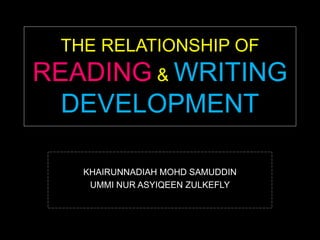
The relationship of reading & writing development
- 1. THE RELATIONSHIP OF READING & WRITING DEVELOPMENT KHAIRUNNADIAH MOHD SAMUDDIN UMMI NUR ASYIQEEN ZULKEFLY
- 2. Are they really connected? (Freedman, & Calf ee, 1984; Goodman, & Goodman, 1983). “Reading and writing have been viewed in a sequential relationship where reading ability initially precedes writing ability, but then writing skills later influence reading skills.”
- 3. Do we read before we write? WHY? • Reading to Build Schemata (Prior knowledge) for Writing • Reading to Develop Specific Writing Skills • Reading to Learn Text Structures • Reading to Reinforce Vocabulary Development
- 4. BUILDING SCHEMATA Reading of constructing meaning BY CONNECTING: ACTIVE PROCESS OLD KNOWLEDGE NEW INFORMATION
- 5. • Use the existing knowledge to provide an outline for learning new information • Change their schema as they discover new perspectives in their reading • The new information is learned best when the relevant prior knowledge integrates them ONLY WRITE WHAT YOU KNOW PROFICIENT READERS
- 6. DEVELOPING SPECIFIC WRITING SKILLS GRAMMAR PUNCTUATION SENTENCE STRUCTURE VOCABULARY CORRECT SPELLING FORMATTING W R I T I N G S K I L L S
- 7. LEARNING TEXT STRUCTURES The organization of information in the written text TEXT STRUCTURE Chronological/ Order Compare/ Contrast Problem/ Solution Cause/ Effect Description Directions
- 8. • Learners get to experience a variety of text structures through reading. • Can anticipate what information will be revealed in a selection • Understanding the pattern of the text helps readers organize ideas for writing their own texts TEXT STRUCTURE WRITER’S TRAIN OF THOUGHTCLUES LOGICAL THINKING COMMUNICATION PATTERNS
- 9. REINFORCING VOCABULARY DEVELOPMENT • Lack of vocabularies is one of the constraints faced by learners in writing the essay • Reading exposes learners to many new words and phrases that they learn to use in their own writings • A significant increase on vocabulary with each reading experience
- 10. READING as Teaching Approach for WRITING Read Like a Writer Approach Text Analysis Approach
- 11. READ LIKE A WRITER APPROACH • Designed by Steve Peha (2003) • Read from the perspective of a writer • Aim: to develop a sense of how the text works • Focus: how the writer is saying it • Looks at the techniques the writer uses to get his or her message across and how those techniques affect us as we experience the text
- 12. WHY? When one reads like a writer • Close attention is paid to the writer’s techniques and how those techniques contribute to the meaning of the piece and improve its quality • May even borrow the techniques one learns for his or her own writing Student can learn and implement or apply writers’ techniques into their own writing.
- 13. • Pay attention to 6 elements Ideas - How does the writer reveal the main idea? What types of details does the writer use? How does the writer achieve his or her purpose? How does the writer’s choice of ideas affect the reader? Organization - What kinds of leads does the writer use and how do they pull us in and make us want to read more? What kinds of endings does the writer use and how do they work to make the writing feel finished and to give us something important to think about? How does the writer handle transitions? What techniques does the writer use for sequencing? How does the writer control pacing? HOW?
- 14. Voice - How does the writer demonstrate passion for the topic? How does the writer reveal emotions? How does the writer put personality into the piece? Word choice - What techniques (simile, metaphor, strong verbs, etc.) does the writer use to make the word choice more specific, more memorable, and more effective? Sentence fluency - What kinds of sentence constructions does the writer use? How does the writer vary the length and construction of his or her sentences? How does the writer use “sound” effects like alliteration, rhyme, and rhythm? Conventions - How does the writer use conventions to make the writing easy to read and more meaningful? Does the author use conventions in unusual ways that are successful?
- 16. TEXT ANALYSIS APPROACH • The idea behind this approach comes from: Learning to write requires knowledge on how different texts are structured and presented. The aimed type of text will vary in terms of its characteristics (topic, medium of communication and mode). To communicate effectively, writers “frame” all possible set of expressions with focus on the central idea or viewpoint.
- 17. • To build schemata for students • To help students successfully match reader and writer’s expectation by comparing characteristics of text types • Provide students with abundant of practical applications in groups and individually 4 elements to be analyzed: • Traits of a text that serve to fulfill a certain purpose • Aim of text how is being achieved • Text configuration and its classification • Methods of transition used AIM HOW
- 18. • Reading and writing mutually reinforce each other. • A lot of research articles = correlation between reading and writing but not much on how we can exploit this correlation into practice • Teachers prefer to let writing lesson to be as homework or self-study but students want some guidance • Nutbrown (2006) – “Learning to write well is complex process that cannot be achieved if the learner is working without examples, some clear instruction of how and why language works as it does and opportunities to practice” What can be concluded?
